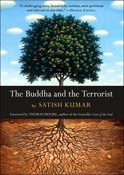Wednesday, May 27, 2009
In America, as elsewhere on the planet, terrorism in the name of religious fundamentalism seems to be humankind's currently unavoidable cause of suffering, providing fertile fields for bigotry, hatred, wars and devastation on a worldwide scale. With that global issue in mind, peace activist Satish Kumar brings to life the ancient story of "The Buddha and the Terrorist" (Algonquin Books, 2006, $12.95).
Many people consider Buddhism a "godless" religion, which is not strictly true; Buddhist scripture is filled with dozens of gods and goddesses. They are not held as real beings in practice, but as mythic figures. The Buddha, however, is not a god and never represents himself as such. He was born Siddhartha Gautama around 583 B.C., and became an enlightened human being, one who came to understand fundamental truths about the human condition and offered others a way of life to elevate them from the daily miseries we all share. That human life means suffering, pain and difficulties, the Buddha wrote, is the first of four noble truths, but also humans can attain the cessation of suffering by following the right-fold path of wisdom, ethics and mental development.
This slim volume tells the story of Buddha's encounter with the fearsome murderer Angulimala (Necklace of Fingers), so called because of the bloody necklace he wears made from the fingers of his victims. Rather than avoiding this frightening man who is terrorizing the countryside, Buddha simply goes about his life, neither fearing nor avoiding him. When the two inevitably meet, they have a remarkable conversation that causes Angulimala to renounce violence and take responsibility for his actions.
As the tale unwinds, the people of the region petition their king to hunt down and kill Angulimala for his heinous crimes. When the king finds the terrorist, however, he has become a monk, having joined the Buddha's monastery, and the Buddha has renamed him Ahimsaka (the nonviolent one). The man's spiritual understanding and compassion astonishes the king. Realizing that this former terrorist has truly changed, the king does not have him killed.
Ahimsaka, though, in acknowledging his responsibility, knows he cannot hide from the people he has harmed, saying, "I must confront my past, and face the future." In the chapters that follow, "The Buddhist and the Terrorist" becomes a fable for the 21st century, showing us the difficult yet peaceful path of responsibility, forgiveness and redemption, the other side of coins called shame, blame and vengeance.
The people put Ahimsaka on trial for his crimes, and they hear testimony from the victims' families, hear the teachings of the Buddha, the Mahavira (the Jina, founder of the Jain religion), and finally, words from a young widow.
In its 115 small pages, "The Buddha and the Terrorist" does much more than tell a fanciful parable. It also outlines and explains the great ideas contained in the Buddhist religion—the four noble truths and the eight-fold path—in easy-to-understand prose. As such, the book is a tiny marvel for anyone who is searching or working for peace, and also for those who wish to understand the basics of Buddhism.
It may take you no more than an hour to read, but expect to study its teachings for a lifetime.
